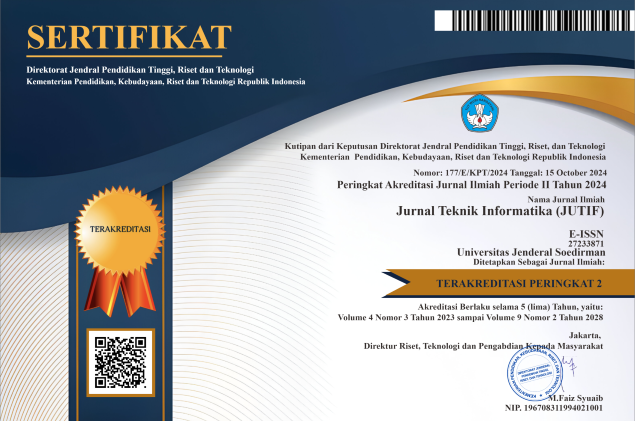DESIGNING UI/UX FOR A MEDITERRANEAN DIET APP TO MINIMIZE TYPE 2 DIABETES RISK
DOI:
https://doi.org/10.52436/1.jutif.2024.5.4.1932Keywords:
Mediterranean Diet, Type 2 Diabetes Melitus, User Centered Design, User Interface, User ExperienceAbstract
The industrial revolution has had a significant impact in health field, where the crucial disease in Indonesia is Type 2 Diabetes Mellitus (T2DM). One of the effective ways to minimize the increase in T2DM is by developing a diet application using Mediterranean diet Method. The Mediterranean diet involves controlling certain types of foods and beverages, characterized by high intake of fruits, vegetables, whole grains, nuts, legumes, moderate consumption of fish, low intake of red/processed meat, and low intake of high-fat dairy products. In this research and design, the Author applied User Centered Design (UCD) method, which encompasses User Interface (UI) and User Experience (UX). The author also applied the UX law (Hick’s Law, Law of Proximity, dan Aesthetic-usability Effect) on designing the user interface. This article included a A/B Testing and System Usability Scale (SUS) result that showed an interesting findings, where the design that achieved a higher success rate had a lower user satisfaction score and vice versa. However, both designs have an acceptable score and C grade.
Downloads
References
Kementrian Kesehatan, “Informasi Data Diabetes Tahun 2019,” 2019.
M. Georgoulis, M. D. Kontogianni, and N. Yiannakouris, “Mediterranean diet and diabetes: Prevention and treatment,” Nutrients, vol. 6, no. 4, pp. 1406–1423, Apr. 2014, doi: 10.3390/nu6041406.
E. Puspita Sari, “HUBUNGAN ANTARA BODY DISSACTISFACTION DENGAN KECENDERUNGAN PERILAKU DIET PADA REMAJA PUTRI,” 2019. [Online]. Available: https://www.researchgate.net/publication/332510927
L. Haigh et al., “The effectiveness and acceptability of Mediterranean diet and calorie restriction in non-alcoholic fatty liver disease (NAFLD): A systematic review and meta-analysis,” Clinical Nutrition, vol. 41, no. 9, pp. 1913–1931, Sep. 2022, doi: 10.1016/j.clnu.2022.06.037.
B. Roman, L. Carta, Á. M. Martínez-González, and L. Serra-Majem, “Effectiveness of the Mediterranean diet in the elderly,” Clinical Interventions in Aging, vol. 3, no. 1. pp. 97–109, 2008. doi: 10.2147/cia.s1349.
US HEALTH NEWS, “Best Diets 2023.” Accessed: Jun. 11, 2023. [Online]. Available: Best Diets 2023
G. Caprara, “Mediterranean-type dietary pattern and physical activity: The winning combination to counteract the rising burden of non-communicable diseases (NCDS),” Nutrients, vol. 13, no. 2. MDPI AG, pp. 1–37, Feb. 01, 2021. doi: 10.3390/nu13020429.
J. P. Krabbe and Michael Gontarek, “The Role of a Mediterranean Diet in the Prevention of Type 2 Diabetes Mellitus,” 2023. [Online]. Available: https://www.researchgate.net/publication/372499056
M. Shidqi Hadafi, dan Bambang Agus Herlambang, G. Pusat Lantai, and J. Sidodadi Timur, PENGEMBANGAN UI/UX DESIGN STUDI KASUS APLIKASI CAMPAIGN MENGGUNAKAN METODE DESIGN THINKING, vol. 6. 2021.
H. Joo, “A Study on Understanding of UI and UX, and Understanding of Design According to User Interface Change,” 2017. [Online]. Available: http://www.ripublication.com
M. Agus Muhyidin, M. A. Sulhan, and A. Sevtiana, “PERANCANGAN UI/UX APLIKASI MY CIC LAYANAN INFORMASI AKADEMIK MAHASISWA MENGGUNAKAN APLIKASI FIGMA,” 2020. [Online]. Available: https://my.cic.ac.id/.
H. J. Christanto, S. A. Sutresno, G. D. G. E. Sidabutar, J. A. Seah, S. B. Tjhang, and Y. Krisrian, “Pengembangan Platform Coffee Shop KURLEB dengan Fokus pada User Interface dan Prinsip UX Law,” Journal of Information System Research (JOSH), vol. 5, no. 1, pp. 293–301, Oct. 2023, doi: 10.47065/josh.v5i1.3793.
T. O. Kvålseth, “Hick’s law equivalent for reaction time to individual stimuli,” British Journal of Mathematical and Statistical Psychology, vol. 74, no. S1, pp. 275–293, Jul. 2021, doi: 10.1111/bmsp.12232.
M. A. Maulyda, Sugiman, W. Wuryandani, and Y. W. Purnomo, “How Do Prospective Teachers Find Number Patterns Based on the Laws of Proximity, Closure, and Similarity in a Problem-Solving Activity?,” Acta Scientiae, vol. 25, no. 5, pp. 275–302, Sep. 2023, doi: 10.17648/acta.scientiae.7770.
A. Sonderegger, A. Uebelbacher, M. Pugliese, and J. Sauer, “The influence of aesthetics in usability testing: The case of dual-domain products,” in Conference on Human Factors in Computing Systems - Proceedings, Association for Computing Machinery, 2014, pp. 21–30. doi: 10.1145/2556288.2557419.
A. Miniukovich and K. Figl, “The effect of prototypicality on webpage aesthetics, usability, and trustworthiness,” Int. J. Human-Computer Studies, vol. 179, p. 103103, 2023, doi: 10.7910/DVN/9F.
A. P. Heryanti et al., “Pengenalan dan Pelatihan Figma untuk Pelajar SMA Al-Fityan Tangerang pada Kegiatan Gerakan Nasional Revolusi Mental,” Prosiding Seminar Nasional Pemberdayaan Masyarakat (SENDAMAS), vol. 3, no. 1, p. 22, Feb. 2024, doi: 10.36722/psn.v3i1.2466.
M. Multazam, I. V Paputungan, and B. Suranto, “Perancangan User Interface dan User Experience pada Placeplus menggunakan pendekatan User Centered Design,” 2020.
Useberry, “Useberry: UX Research Platform.” Accessed: Aug. 10, 2023. [Online]. Available: https://app.useberry.com/
F. Quin, D. Weyns, M. Galster, and C. C. Silva, “A/B Testing: A Systematic Literature Review,” 2023. [Online]. Available: https://ssrn.com/abstract=4549495
M. M. Hyzy et al., “System Usability Scale Scores for Digital Health Apps: Meta Analysis,” 2022, doi: 10.2196/preprints.37290.
A. Kathleen, R. P. Sutanto, and A. Pranayama, “ANALISIS PERBANDINGAN USER FLOW DARI APLIKASI E-CATALOGUE IFURNHOLIC,” 2021.
C.-J. Huang and J. Kolopitawondal, “User Experience Design and Evaluation on Mobile Investment Application User Interface Prototype,” in Usability and User Experience, AHFE International, 2023. doi: 10.54941/ahfe1003192.
R. Wahyuningrum, D. Wahyono, M. Mustofa, and Y. S. Prabandari, “Masalah-Masalah terkait Pengobatan Diabetes Melitus Tipe 2: Sebuah Studi Kualitatif,” Indonesian Journal of Clinical Pharmacy, vol. 9, no. 1, p. 26, Mar. 2020, doi: 10.15416/ijcp.2020.9.1.26.



























